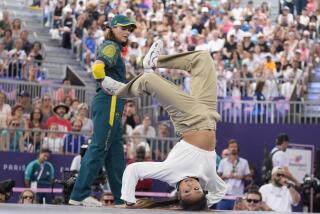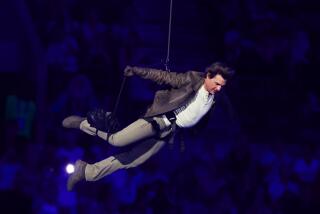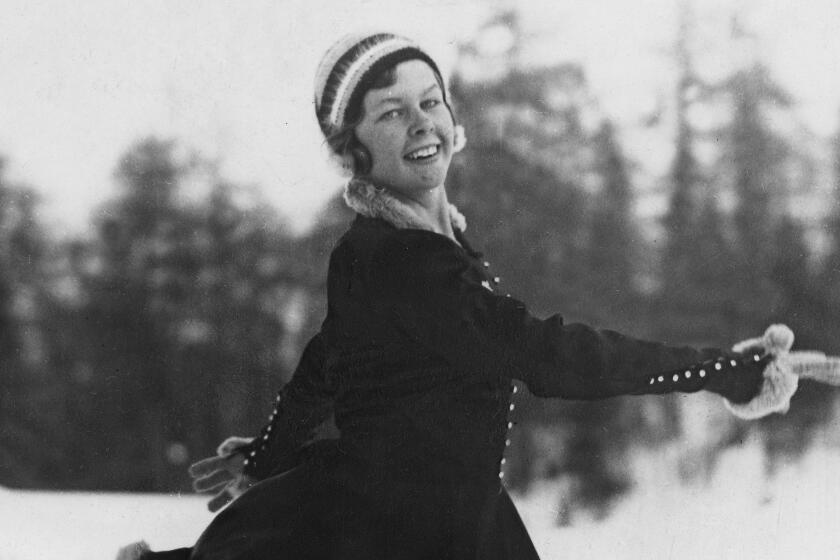Still Changing
SALT LAKE CITY — The principle has been the same from the start: If it works on ice or snow, it works in the Winter Olympics.
Over the years, the Winter Games have included sports such as motorcycle racing, skiing while being pulled by reindeer, and even ballooning--apparently the only connection between ice and snow and ballooning was that you eventually had to land on one or the other.
Little has been predictable, simple or unemotional in the 79-year history of this cold-weather sporting extravaganza that started with the 1924 Games in Chamonix, France, and fittingly, wasn’t even officially designated an Olympics until two years later.
The history of the Winter Olympics represents thousands of people, including visionaries, pioneers, heroes and even some villains. That history continues with the 19th Winter edition, the 2002 Salt Lake City Games.
But with a price tag of $1.9 billion to stage and an NBC rights fee of $545 million to televise, perhaps the only constant from Chamonix in 1924 to Salt Lake City in 2002 is, well, ice and snow.
Nordic Games Holdout
Were Viktor Balck of Sweden to look in on the proceedings of the next two weeks, he would probably be furious.
At the turn of the century, Balck was one of the original members of the International Olympic Committee. The nurturing care and feeding of the Olympic movement was his duty. But his passion was Sweden’s Nordic Games. They were a driving force for nationalism and commercialism and reflected the lifestyle high in the Northern hemisphere, where summer, some years, was just a rumor.
Opera and theater were included in Balck’s Nordic Games in those years. But it was skaters and skiers who captured the public’s fancy--and eventually the fancy of the IOC, which had been running Summer Games since 1896 in Athens.
Balck resisted the IOC’s advances. And for several years, the IOC appeared sympathetic to the wishes of Balck and the Swedes to keep the exclusivity of this winter cash cow.
But even back then, the IOC had a sharp eye for enriching its coffers.
When the IOC announced that it would hold a “Winter Sports Festival” in Chamonix in 1924, it promised not to tread on the Nordic Games. It even banned the phrase “Winter Olympic Games” during the festival, which was a success.
The IOC voted in 1926 to retroactively refer to the festival as the first Olympic Winter Games. That year also marked the last Nordic Games. It had little chance of survival after the IOC’s revisionist history, none after Balck died in 1928.
And so, what was born in a meeting room--albeit two years after the fact--became a regular Olympic undertaking, missing only the war years of 1940 and ’44 and becoming only a slightly scaled-down version of its aesthetically, commercially and politically successful big brother, the Summer Olympics.
A Vehicle in U.S.
Before Salt Lake, the United States had been host of three Winter Olympics: the 1932 Games in Lake Placid, the 1960 Games in Squaw Valley and the 1980 Games, which returned to Lake Placid.
The ’32 Games were the vision of Dr. Godfrey Dewey, who saw an opportunity to strike it rich in the tiny hamlet in the Adirondack Mountains that his father developed into the first U.S. winter resort. But financing was a mess, those being the Depression years, and the project foundered until then-New York Gov. Franklin Delano Roosevelt agreed to attend.
Roosevelt’s opponent in the next presidential election, incumbent President Herbert Hoover, had declined the invitation, missing what turned out to be widespread media exposure. Roosevelt’s wife, Eleanor, even got in on the act, taking a highly publicized bobsled run before the Games began.
Roosevelt later beat Hoover, and historians have made much of Roosevelt’s use of the Olympics.
When Alexander Cushing coaxed the IOC to come to Squaw Valley, there wasn’t much there except for a chairlift, two rope tows and a hotel. Cushing, not coincidentally, owned the hotel. Unincorporated, Squaw Valley didn’t have a mayor to travel to Cortina, Italy, to triumphantly participate in the closing ceremony of the 1956 Olympics.
Eventually, at a cost of $20 million that was absorbed primarily by the state of California, an Olympics rose out of the valley, which became, as one writer put it, “Another Disneyland, an artfully created artificial environment.” CBS paid $50,000 to televise the events, and it enjoyed a Disney-produced opening ceremony that included a 1,200-piece band and the release of 2,000 pigeons, some of which stayed around for the duration of the Games, providing numerous unhappy distractions.
Much to the chagrin of Olympic purists, Hollywood followed. Stars such as Art Linkletter did nightly shows during the Games.
Cushing, who started it all, fell into disfavor with Olympic organizers over cost overruns and was replaced by a San Francisco businessman. For his efforts, Cushing received two free tickets to the Games along with his walking papers.
The Games returned to Lake Placid in 1980 after Finland, Vancouver, and Chamonix bowed out. Funding was a concern until the Federal Bureau of Prisons gave $47 million to construct Olympic buildings that would be turned over to it after the Games.
Those Olympics will be forever etched in the public’s mind by the words of sportscaster Al Michaels, who asked as the U.S. hockey team won an impossible gold medal: “Do you believe in miracles?”
But to those who were there, memories of transportation problems may be as vivid.
Thousands of spectators were left standing for hours in the freezing cold while the ill-prepared Lake Placid organizers tried to get buses to them. This prompted the now-famous observation from New York Times sportswriter Dave Anderson, who wrote: “The good news is that the Soviet Union is ready to withdraw its troops from Afghanistan. The bad news is that the Lake Placid Organizing Committee has the contract to bus them out.”
Prime Time in the Rink
Figure skating has generated some of the biggest headlines from the Winter Games. But it was originally part of the Summer Olympics.
Skater Ulrich Salchow won the gold during the 1908 Games in London and tried to repeat at age 42 in Antwerp. Salchow jumped and spun, then hit the rail, suffering an injury and the loss of a medal. One of the sport’s moves is named after him, but his fame has taken on new proportions through the magic of television advertising, which puts him, figuratively, in the same boat with NFL hall of famer Lawrence Taylor, Olympic figure skating gold medalist Brian Boitano and somebody in a clown head selling burgers.
Salchow’s crash was about as violent as it got in figure skating, until the era of Tonya Harding and Nancy Kerrigan, pre-Lillehammer 1994.
Harding was rough-around-the-edges, learning how to change the oil in her car and shoot deer well before becoming a world-class figure skater. Kerrigan was almost Barbie-doll-like in appearance, poised and skilled in performance.
As Olympic team selection drew closer, Harding complained about her chances to her husband, who came up with a plan. A month before the Games, Kerrigan stepped off the ice after a practice session in Detroit and was confronted by a burly man who whacked her on the knee with an iron rod.
Amid one of sports’ biggest media circuses, Kerrigan recovered to compete in the Games and win the silver. Harding, who was later found to be knowledgeable of the plot, finished eighth.
The grace and charm of the sport was symbolized best by Sonja Henie of Norway, who was there when women’s figure skating was unveiled as a Winter Olympic sport at Chamonix. Herma Planck-Szabo of Austria won that gold in 1924, but in eighth place was 11-year-old Henie, who received much notice with her spins and jumps.
She won gold medals at the next three Winter Olympics, retired at age 23 to go to Hollywood, signed with 20th Century Fox and made one successful movie and nine bad ones. Along the way, she married New York Yankee owner Dan Topping, divorced him and went back home to Norway, where she married her childhood sweetheart. When she died of leukemia at age 57, she was worth $43 million.
The closest thing to Henie’s male counterpart in figure skating is American Dick Button, who won the gold in 1948 and ’52 and dazzled the skating world with a successful triple loop. Button went on to a successful broadcasting career, continuing today.
Speedskating Saga
Speedskating also has had its years as a glamour sport.
Lydia Skoblikova of the Soviet Union won a total of six gold medals in the 1960 and ’64 Games, more than any woman. Bonnie Blair of the United States won five golds and a total of six medals in the 1988, ’92 and ’94 Games, most for any American woman. American Eric Heiden managed five golds in 1980 alone.
Perhaps the best-known competitor in Olympic speedskating is American Dan Jansen, who dominated world events in the ‘80s and early ‘90s but skated a long, cruel road in quest of Olympic gold.
Favored to win at least two gold medals in Calgary in 1988, he was told on the eve of his first race that his sister, Jane, had died after a long illness. Jansen started the 500 meters, slipped and fell. No medal. After leaving the Games to attend the funeral, he returned, started the 1,000 meters, slipped and fell. No medal.
He tried again in Albertville, France, in ‘92, but skated poorly, finishing fourth and 26th.
In Lillehammer, his story was so well documented that his every step, or misstep, became headlines, Jansen entered the 500, slipped again and finished eighth. That left him with one more race in his Olympic career, the 1,000. He bobbled again on the second-last turn, nearly falling as the crowd audibly gasped in horror. But a determined Jansen recovered, picked up speed and crossed the finish line, not only with a gold medal, but in world-record time.
The sports world stood, cheered and celebrated. Then it sobbed as Jansen interrupted his victory lap to pick up his infant daughter and carry her as he skated. She was named Jane, after his late sister.
Ski It to Believe It
Two Americans named Bill, mountains apart in personality, brought their share of drama to the Games.
Bill Johnson, a brash downhill skier who hadn’t been considered at all until he won a World Cup race a few months before the ’84 Games in Sarajevo, Yugoslavia, told the world on the eve of the Olympic event: “Everybody else should just aim for second place.”
That infuriated the Europeans, who had dominated the event--no U.S. man had won a medal in downhill, much less a gold--and Johnson was labeled a cocky Yank. He fulfilled his prediction, but his feat was dismissed because it was achieved on what the Europeans said was an easy course. To which Johnson replied, “If it was so easy, why didn’t they win?”
There was no such bravado from Bill Koch, a cross-country skier from Vermont, who, in the ’76 Games in Innsbruck turned in a silver-medal performance in the 30-kilometer cross country event. Koch’s medal was so far out of the realm of possibility--it was the first medal, and the only one to date, for an American in cross-country--that no member of the U.S. media witnessed it.
According to David Wallechinsky in “The Complete Book of the Winter Olympics,” when a reporter finally chased Koch down and asked him if he had lived in Vermont all his life, Koch responded with the classic, “Not yet.”
Koch made a symbolic comeback of sorts in Albertville, finishing 42nd. Johnson attempted a comeback last year, but crashed and suffered severe injuries.
If Johnson was a rough-cut swashbuckler, a more refined version was handsome Frenchman Jean-Claude Killy, who won the triple crown of Alpine skiing, the slalom, combined slalom and downhill, during his home games at Grenoble in 1968. Then, 24 years later, he led the effort to bring the Games back to France by convincing the IOC that a nondescript city in the midst of the French Alps was an ideal place from which to send athletes into competition. The ’92 Games went to Albertville--and the surrounding Savoy.
Around the Edges
Viewers may enjoy the next two weeks of Winter Olympics with the knowledge that they have something for everybody:
There was a curmudgeon:
* Former IOC President Avery Brundage, who railed for years about the sins of commercialism intruding on his image of purity and amateurism, especially disliked the winter version of his Olympics because of its many opportunities for brand identification decals on skis and jackets. The aristocratic American banned a number of skiers over the years for endorsing products, and once called Alpine skiing “a poisonous tumor to be immediately operated on.”
No perceived violation was too small for Brundage to ferret out. When Canadian figure skater Barbara Ann Scott won a gold medal in the 1947 World Championships, becoming the first North American to do so, friends gave her a yellow convertible. Brundage said keeping it would make her a professional and demanded that she give it back. She did, in tears, but after winning the Olympic gold in the ’48 Olympics in St. Moritz, she turned pro and reclaimed it.
There has been international intrigue:
* A German bobsledder alienated his teammates during the 1992 Games by admitting that he had been an informer for the East German secret police.
* In 1960, when the U.S. hockey team was performing its first miracle on ice, it had to beat Czechoslovakia in the final and was trailing, 4-3, after two periods. The Soviet captain, whose team was no longer in the running but who hated the Czechs more than the Americans, found his way into the U.S. locker room between periods and suggested that the Americans take oxygen in the altitude at Squaw Valley. They did, scored six goals and won, 9-4.
There has been international embarrassment:
* In ’64 at Innsbruck, the hockey game between Sweden and Canada was disrupted when Sweden’s Karl Oberg bashed the Canadian coach, Father David Bauer, a Catholic priest, over the head with his stick. In a remarkable show of poise and restraint, Father Bauer did not allow his team to retaliate and the referee was eventually suspended for failing to penalize Oberg.
* In Nagano 34 years later, the embarrassment was American, when its hockey team, the first group of pros to participate under new rules, fared poorly and then trashed their rooms in the athletes’ village.
There has been heroism, some of it away from the predictable areas of competition:
* In 1932 in Lake Placid, American Billy Fiske drove his bobsled team to a gold medal. But earlier in the competition, the German bobsled team had crashed, wrecking the sled and injuring teammates. Fiske led efforts to scrounge up extra bobsled parts and recruited members of the nearby German-American community to man the German sled. Fiske later became the first American to die in World War II when his plane was shot down by the Germans.
* The Austrian Army came to the rescue in Innsbruck when Mother Nature failed to provide snow in the days before the ’64 Games. Soldiers drove to snowy areas, shoveled the snow into trucks and unloaded it on the hills.
And, of course, there has been love:
* In the ’72 Games, the Soviet figure skating pairs team of Irina Rodnina and Aleksei Ulanov beat another Soviet team, of Lyudmila Smirnova and Andrei Suraikin. But Ulanov had become romantically involved with Smirnova, and so the joy of the final result was tempered by personal feelings and emotion. Rodnina, who shared the gold with Ulanov, skated off the ice in tears.
* And then there was Katarina Witt, the German beauty who had won her first figure skating gold medal in 1984 in Sarajevo. While she was in the process of defending that title in Calgary in 1988, Alberto Tomba, the Italian skiing sensation, was in the process of falling in love, or at least in lust.
One night, deciding to plead his case in person, Tomba showed up at the figure skating venue and wrote a note that he had passed to Witt.
Cupid didn’t connect. Tomba had spelled Katarina’s name wrong.
*
Some research for this story was done at the Amateur Athletic Foundation library in Los Angeles; publications used include “The CBS History of the Olympic Winter Games”; “The First Winter Olympics” by John Lucas, Penn State University; “The Nordic Games and Origins of the Olympic Winter Games” by Ron Edgeworth; “The Complete Book of Winter Olympics” by David Wallechinsky and “Historical Dictionary of the Modern Olympic Movement,” edited by John Findling and Kimberly Pelle.
*
(BEGIN TEXT OF INFOBOX)
TRACKING THE WINTER GAMES
1924...Chamonix, France
1928...St. Moritz, Switzerland
1932...Lake Placid, N.Y.
1936...Garmisch-Partenkirchen,
Germany
1940...Canceled, war years
1944...Canceled, war years
1948...St. Moritz
1952...Oslo
1956...Cortina D’Ampezzo,
Italy
1960...Squaw Valley, Calif.
1964...Innsbruck, Austria
1968...Grenoble, France
1972...Sapporo, Japan
1976...Innsbruck
1980...Lake Placid, N.Y.
1984...Sarajevo, Yugoslavia
1988...Calgary, Canada
1992...Albertville, France
1994...Lillehammer, Norway
1998...Nagano, Japan
2002...Salt Lake City, Utah
2006...Turin, Italy
More to Read
Go beyond the scoreboard
Get the latest on L.A.'s teams in the daily Sports Report newsletter.
You may occasionally receive promotional content from the Los Angeles Times.








